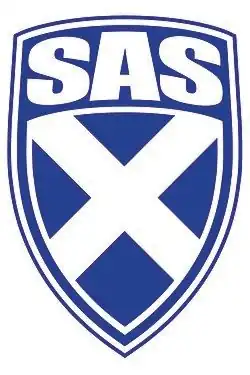St. Andrew's-Sewanee School
St. Andrew’s-Sewanee School is a private, coeducational, Episcopal, boarding and day college preparatory school serving 250 students in grades six through twelve. It is located in Sewanee, Tennessee on the Cumberland Plateau between Nashville and Chattanooga and adjacent to the University of the South, which is also affiliated with the Episcopal Church. In addition to outstanding college preparation, the school is known for its close and welcoming community, emphasis on creativity, and opportunities for outdoor adventure.
| St. Andrew's-Sewanee School | |
|---|---|
 St. Andrew's-Sewanee Shield | |
| Address | |
290 Quintard Road , 37375 | |
| Coordinates | 35.2172°N 85.8914°W |
| Information | |
| School type | Private, Day & Boarding |
| Religious affiliation(s) | Episcopal |
| Established | 1868 1905 1981 (merger) |
| Head of School | Karl J. Sjolund |
| Faculty | 41 teachers |
| Grades | 6 to 12 |
| Gender | Coeducational |
| Enrollment | 250 students (30% boarding) |
| Student to teacher ratio | 5:1 |
| Campus size | 550 acres (2.2 km2) |
| Campus type | Rural |
| Color(s) | Blue and Gold |
| Athletics | 25 teams in 10 sports |
| Athletics conference | TSSAA |
| Mascot | Mountain Lion |
| Yearbook | The Phoenix |
| Endowment | $19 million |
| Website | sasweb.org |
History
The current school, housed on 550 acres (2.2 km2), is the result of the merger of St. Andrew's School, which was located on the same campus, and the Sewanee Academy.[1] The University of the South agreed to merge the Sewanee Academy with St. Andrew's School in 1981.
Sewanee Academy was founded in 1867 as the Junior Department of the University of the South and later became Sewanee Grammar School (1869-1908), then the Sewanee Military Academy. In 1971, Sewanee Military Academy dropped its military program and became known as simply the Sewanee Academy, with a coeducational student body, for the next 10 years.[1] After the 1981 merger and subsequent relocation, the former Academy property was given to the University's School of Theology for use; the school moved from the St. Luke's Hall on the main campus.
St. Andrew's School was founded in 1905 by the Episcopal Order of the Holy Cross (Anglican monastics) with the goal of "breaking the cycle of poverty" for "mountain boys." Originally all-white, St. Andrew's was desegregated in 1965.[2]
A third school, St. Mary's School for Girls, was operated from 1896 to 1968 by the Episcopal Sisters of St. Mary's (also Anglican monastics). After St. Mary's closed, Sewanee Military Academy and St. Andrew's School, which had enrolled only boys, both became coeducational.[1]
Notable alumni and faculty
- James Agee, author
- George R. Allin, American general
- Stephen Barber, composer
- Richard Walker Bolling, Democratic congressman from Missouri
- Sean Bridgers, actor
- Kix Brooks, country music singer of Brooks and Dunn fame
- Bruce Cabot, actor
- Saxby Chambliss, U.S. Senator from Georgia
- Mike deGruy, documentary filmmaker
- Charles Duncan, Jr., entrepreneur and statesman
- George Garrett, Princeton University and University of Virginia professor, poet, novelist, scholar
- Max Gladstone, author
- Eban Goodstein, economist, author and sustainability educator
- William Crawford Gorgas, Surgeon General of the U.S. Army
- Haywood S. Hansell, American major general
- Rip Hawkins, football player
- Robin Hemley, author
- Jack Hitt, journalist and author
- Henry Finch Holland, attorney
- John Jay Hooker, attorney, entrepreneur, Tennessee political gadfly
- David Lodge (biologist), Director of Cornell University's David R. Atkinson Center for a Sustainable Future
- Stuart Margolin, actor (The Rockford Files)
- C.J. McCoy, Florida Gators football coach
- Vail M. Pittman, former governor of Nevada
- Miller Puckette, author of Max (software)
- Elisabeth Röhm, actress
- Walter Sillers Jr., politician
References
- Margaret D. Binnicker, St. Andrew's-Sewanee School, Tennessee Encyclopedia of History and Culture
- Wade H. Morris, Jr., FORCING PROGRESS: THE STRUGGLE TO INTEGRATE SOUTHERN EPISCOPAL SCHOOLS, M.A. thesis, Georgetown University, April 18, 2009 Archived 2011-08-17 at the Wayback Machine